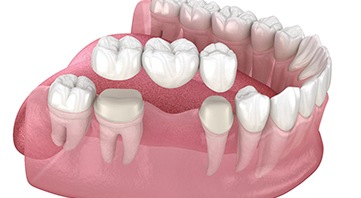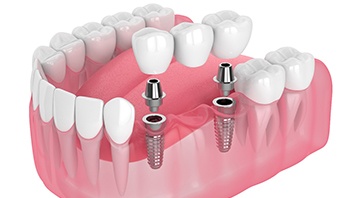Dental Bridges – Monroe, LA
A Convenient Way to Replace Multiple Missing Teeth
Having missing teeth can cause a wide range of complications to your oral health, from an uncomfortable bite to even further tooth loss if left unchecked. Although this is a common problem for people all over the country, you’ll want to seek restorative treatment to help renew your complete smile. Fortunately, Dr. John J. Roberson can provide custom dental bridges in Monroe as a cost-effective way to replace your lost pearly whites. Read on to learn more or give us a call to schedule your consultation.
Why Choose John J. Roberson, DDS for Dental Bridges?
- Professional & Dedicated Dental Staff
- Lifelike & Long-Lasting Treatment Results
- Accepts Insurance & Offers Alternative Financing
What Is a Dental Bridge?

This type of restoration is primarily used to restore one or several consecutively missing teeth. While it usually depends on the patient’s specific needs, the number of teeth replaced can be anywhere between one and four. The dental bridge consists of two crowns connected via pontics (or artificial teeth). The two crowns are designed to fit atop the adjacent teeth on either side of the gap, allowing the pontics to rest above the gumline. This restoration can be constructed out of various materials, including ceramic and porcelain, which often provide a more durable and natural-looking appearance.
Types of Dental Bridges

If your dentist has recommended that a dental bridge would be the ideal solution for restoring your full smile, then you’ll need to go over the two kinds you can expect to receive. Here’s what you need to know about your options:
Traditional Dental Bridge

Should you have strong and healthy natural teeth on both sides of the gap, then a traditional dental bridge may be the effective restoration you’re looking for. For this treatment to work, your abutment teeth (or the permanent teeth used to support the crowns) will need to be prepared by shaving down some of your enamel to make room. This option takes a few visits to complete, but it can work well within your budget.
Implant Bridge

If you have three or more consecutively missing teeth, or you don’t have healthy adjacent ones, then an implant bridge may be the ideal solution. The crowns will instead be anchored directly to your jawbone via metal posts that serve as your new permanent roots. While the process takes longer to finish due to the healing phase, your results can last much longer than traditional bridges and you’ll be able to preserve a strong jawbone in the long run.
The Benefits of Getting a Dental Bridge

Dental bridges come with a wide variety of advantages for your smile. Some of the most essential benefits include:
- Replacing one or multiple missing teeth in a row
- Preserving your other remaining teeth from shifting out of place
- Maintaining a strong jawbone (specifically with an implant bridge)
- Making it easier to eat comfortably and speak clearly
- Providing results that can last 10+ years with proper care (30+ years to a lifetime with implant bridges)
Dental Bridges FAQs
Is a Partial Denture the Same as a Bridge?
No. While partial dentures are sometimes called “removable bridges,” they are not the same thing as a traditional fixed bridge. A bridge is designed to stay in place for many years and can only be removed by a dentist, but a patient can remove their partial denture at any time. The other main difference is that bridges can only replace missing teeth if they are consecutive, whereas partials can bring back several teeth at various points along an arch. Bridges are anchored via crowns that are fitted over two of the remaining teeth, while partials typically use metal clips or clasps that go behind the natural teeth. Your dentist will review your options to determine which tooth replacement would better suit your needs.
How Many Teeth Can a Dental Bridge Replace?
Depending on the patient’s needs, a dental bridge can replace anywhere from one to four missing teeth in a row. However, in most cases, bridges are used to replace only one or two teeth. The longer the bridge extends, the less stable it may become – especially if the natural teeth supporting the bridge aren’t strong and healthy. So, it may become risky to have a bridge replace three or more teeth. Implant bridges can lower this risk, as implants are just as strong and secure as natural teeth, if not more so.
Can Dental Bridges Be Whitened?
No matter the material your bridge is made of, it cannot be whitened like your teeth can. Tooth enamel has tiny pores through which bleaching gels can enter and break apart stains, but dental restorations like bridges do not. Therefore, your bridge should always remain the same color. Metal-free bridges are designed to blend in with your remaining teeth as closely as possible. To minimize the risk of your natural teeth becoming discolored and making your bridge stand out in your smile, consider asking your dentist about getting teeth whitening before your bridge is placed. That way, your bridge will be matched to the ideal shade of your teeth.
Do Dental Bridges Look Natural?
Metal-free bridges are made from ceramic, zirconia, and other materials that can be color-matched to your other teeth. These materials look remarkably like tooth enamel, even in the way that light bounces off of them. Once placed, your bridge should blend in with the rest of your smile quite well. Bridges made from metals like gold and silver obviously won’t look natural, but they’re typically only used for teeth that aren’t visible in the smile. With bridges, you won’t need to worry about your prosthetic falling out, like you might with a denture.
